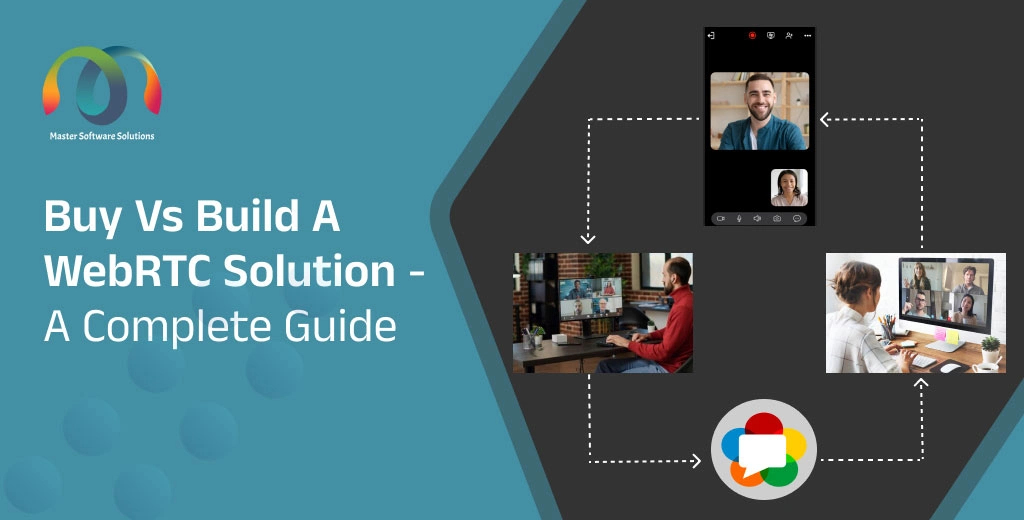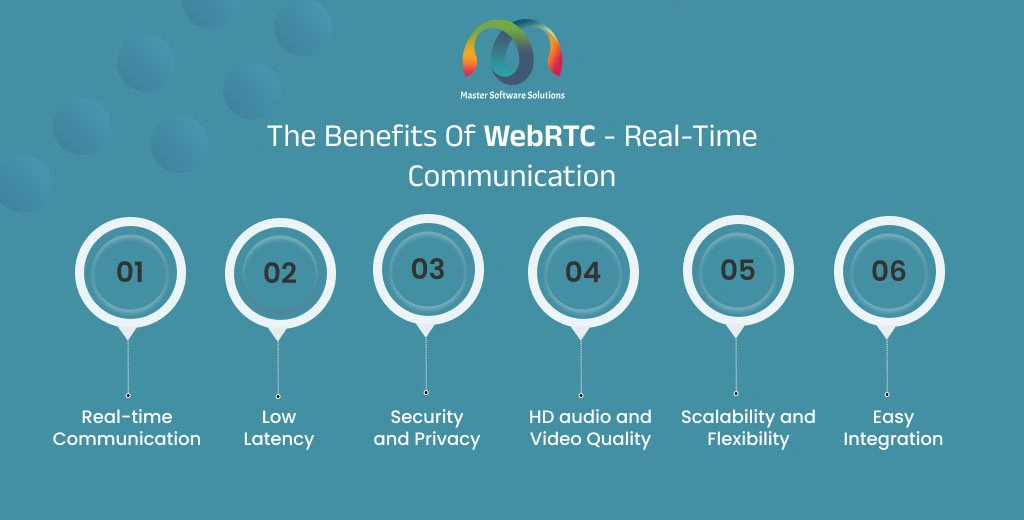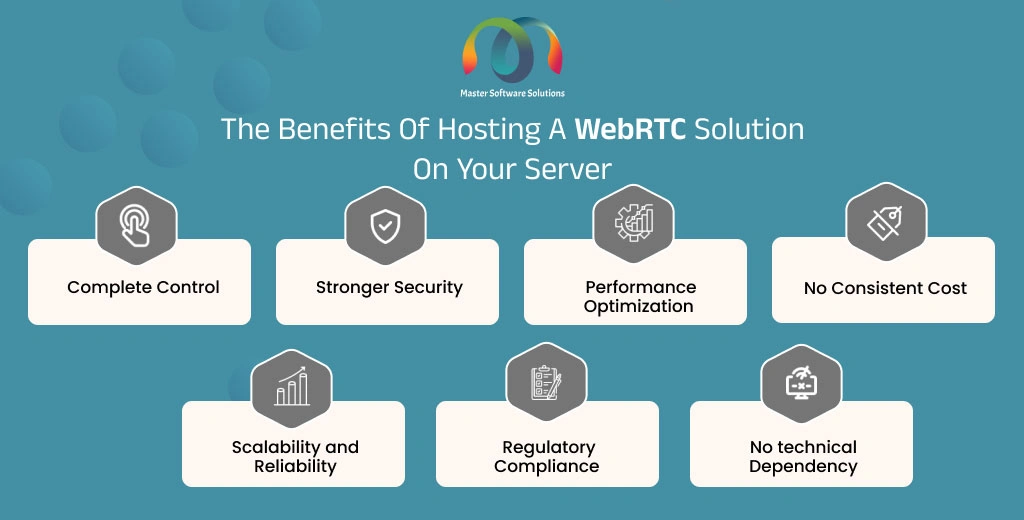Buy or Build a WebRTC Solution – A Complete Guide
Table of Content
- WebRTC – Brief Introduction
- When was WebRTC created?
- What are the features of WebRTC?
- What are the benefits of WebRTC?
- Which industries use WebRTC?
- Should I buy or build a WebRTC solution?
- Challenges in using cloud-based WebRTC solution
- Benefits of hosting WebRTC solution on your server
- Is WebRTC free?
- WebRTC – security and privacy
- Conclusion
WebRTC – Brief Introduction
Web Real-Time Communication is an open-source set of protocols or APIs that help developers create real-time communication web or mobile applications for voice, video, or messaging. Developers use these APIs to establish a peer-to-peer connection between the browser or application without integrating plugins or downloading software.
When was WebRTC created?
Google created WebRTC in 2011, which underwent a standardization process with the Internet Engineering Task Force (IETF) and the World Wide Web Consortium (W3C) to ensure platform interoperability. Over time, major web browsers have adopted and implemented support for WebRTC, including Microsoft Edge, Mozilla Firefox, and Google Chrome.
What are the features of WebRTC?
WebRTC offers robust features that help developers design and develop real-time communication web and mobile applications. The features of WebRTC real-time communication are:
- Peer-to-peer communication – Allows browsers or applications to connect directly without plugins or middle servers.
- GetUserMedia API – Gives users access to audio and video streaming devices, like microphones and webcams.
- Data Channel – Allows peer-to-peer connection with arbitrary data type.
- Cross-platform compatibility – Major web browsers support WebRTC, which includes Microsoft Edge, Mozilla Firefox, and Google Chrome.
- Adaptive Bitrate Control – Adjusts the quality of the audio and video streams based on the network conditions.
- DTLS and SRTP – Encryptions used in WebRTC to ensure security and privacy.
What are the benefits of WebRTC?
WebRTC is an open-source platform and offers great real-time communication benefits, making it easy for developers to create real-time communication solutions. The benefits of WebRTC real-time communication are:
- Real-time communication – WebRTC enables communication in real-time, eliminating third-party integrations or plugins.
- Low latency – Ensures data is transmitted and received with minimal delay.
- Security and Privacy – Uses encryption to ensure the security and privacy of the user.
- HD audio and video quality – Offers high-quality audio and video quality. It can adjust audio and video quality according to the network conditions.
- Scalability and flexibility – WebRTC allows developers to create one-on-one calls and large-scale video conferencing applications.
- Easy integration – Allows developers to use WebRTC APIs to improve the features of real-time communication solutions.
Which industries use WebRTC?
WebRTC is now used in various industries, like education or e-learning, media and entertainment, telemedicine and remote patient care, remote collaboration in corporate, event planning and legal services, and gaming and streaming.
Should I buy or build a WebRTC solution?
Buying or building a WebRTC solution depends on your business requirements. Businesses, especially those looking to move quickly and efficiently, prefer buying a WebRTC solution. Buying a WebRTC solution can offer numerous benefits, like faster deployment, lower initial costs, and high reliability. However, it can limit you when looking to improve or add new features.
On the other hand, developing a WebRTC solution can be a key investment, offering you flexibility, control, and customization. Although it might be expensive and require technical expertise, the long-term benefits of owning and controlling your application architecture are more important. Developing and hosting your WebRTC solution on your server ensures that it aligns perfectly with your business needs. It provides a secure, scalable, and high-performing platform for real communication.
Challenges in using cloud-based WebRTC solution
Implementing a cloud-based WebRTC solution is cost-effective, however, it comes with its own set of challenges. It restricts you from making customizations and other configurations that can limit your business’s growth.
Some of the primary challenges in using cloud-based WebRTC solutions are:
- Limited scalability – Handling large volumes of users requires sophisticated traffic management strategies and load balancing. In cloud WebRTC solutions, dynamic resource allocation is limited, and fluctuating demands can’t be met. As the number of users grows, ensuring low latency and high-quality media streams is challenging.
- Latency and network issues – The level of latency can vary based on the location of the users. It can affect the quality of communication. Inconsistency in the network and limitations in bandwidth can decrease the user experience. You can not optimize the network path and minimize delays with cloud-based solutions.
- Security and privacy – As you are not hosting the application on your server, ensuring end-to-end encryption to protect sensitive information is difficult. You can not implement any methods in the solution to prevent unauthorized access and secure user identities.
- Quality of service – Varying network conditions complicate maintaining audio and video quality. The audio and video quality cannot be dynamically adjusted with an adaptive bitrate algorithm in cloud WebRTC solutions. You can develop and implement strategies to handle packet loss, jitter, and other network issues.
- Server infrastructure – You do not have control of the server. It restricts you from deploying and managing STUN and TURN servers for NAT transversal. You cannot choose the location of servers to minimize latency and maximize performance. You can not monitor server performance or maintain infrastructure.
Benefits of hosting a WebRTC solution on your server
Building and hosting your WebRTC solution on your server allows you to create a tailored solution that aligns seamlessly with your requirements. While it might require a higher investment, the benefits of control, security, and flexibility are great, especially for businesses with performance and regulatory needs.
The benefits of hosting a WebRTC solution on your server are:
- Complete control – You can customize the platform to your requirements because you have complete control over the software stack. You can also tailor server settings and network configurations to optimize performance and security.
- Stronger security – Hosting on your server ensures controlled data. It reduces the risk of data breaches or exposure to third parties. Enforcing your data security policies allows you to implement advanced encryption and authentication mechanisms.
- Performance optimization – You have the control to optimize resource allocation to ensure high performance and low latency for a particular use case. This direct control over the network allows for fine-tuning to minimize latency and maximize reliability.
- No consistent cost – You can avoid recurring costs associated with cloud service providers. It is beneficial for your business as your user base grows. It makes the cost structure more predictable as you are subjected to the cost fluctuations in cloud service pricing.
- Scalability and reliability – You can implement custom scalability solutions tailored to your specific needs, allowing for efficient handling of large users. It enables you to efficiently manage and scale hardware resources without relying on third-party infrastructure. Managing your infrastructure and reducing dependence on external service providers ensures consistent uptime. It gives you direct control over maintenance schedules, which reduces downtime and service interruptions.
- Regulatory compliance – You can easily meet specific regulatory and compliance requirements by processing and storing data in a controlled environment. It keeps the data within the chosen geographical area, ensuring data sovereignty.
- No technical dependency – You can change or upgrade your tech stack without being tied to a cloud provider. It gives you the flexibility to implement custom features and integrations without restrictions from third- parties.
Is WebRTC free?
Yes, WebRTC is open-source, which means a free set of protocols or APIs for developers to design real-time communication applications. Then, why are companies paying to create a WebRTC solution?
WebRTC is a set of protocols that are available to everyone on the internet. You need to hire a WebRTC expert to customize, integrate, configure, and maintain the platform to create a tailored solution that aligns perfectly with your business requirements.
How much time is needed to build a WebRTC solution?
The time required to develop a WebRTC solution can vary depending on the requirements of your project. It can vary from 3 months to 6 months, approximately. For example, it took 6 months to complete the project for one of our clients- “Realtime Audio.”
Conclusion
It is a critical decision to make whether to buy or build a WebRTC solution that fits perfectly with your custom business needs, resources, and goals. Buying a WebRTC cloud solution offers advantages like rapid deployment and lower initial costs. However, building your WebRTC solution provides flexibility to customize every feature of their real-time communication platform, allowing them to meet specific operational needs. This can empower companies to integrate advanced security measures, implement innovative features, and maintain complete ownership over their technology stack.
Book a free WebRTC consultation with us to discuss your project and see how we can help you build your white-label WebRTC application.


